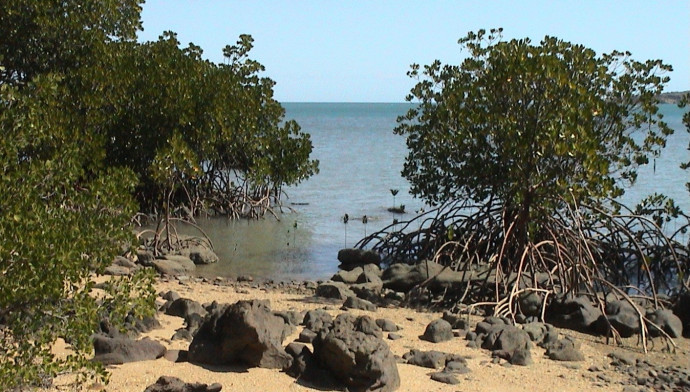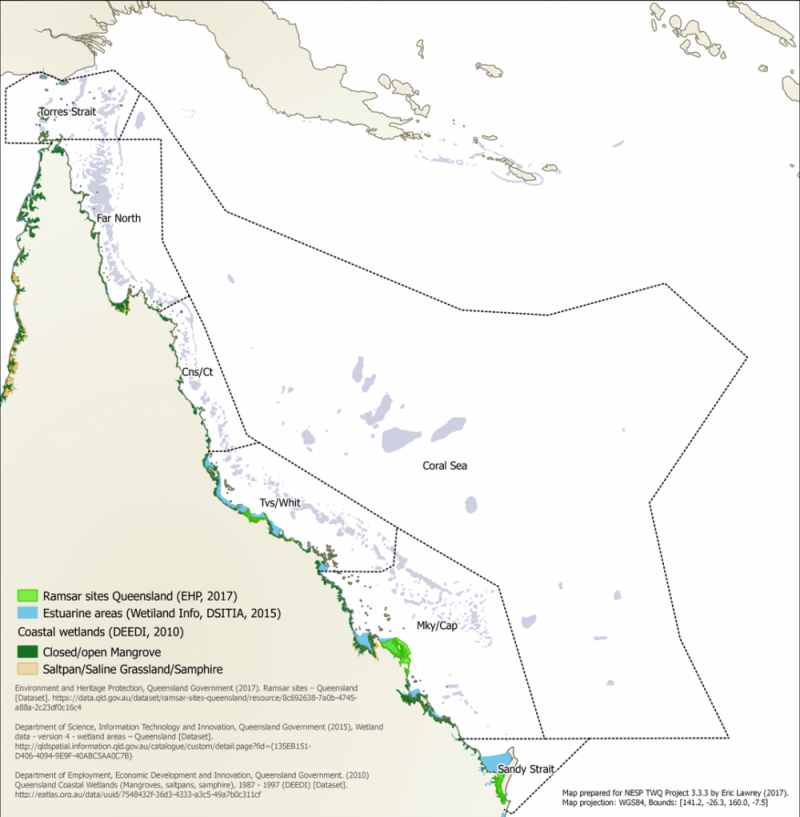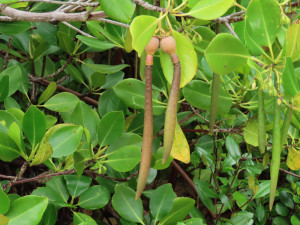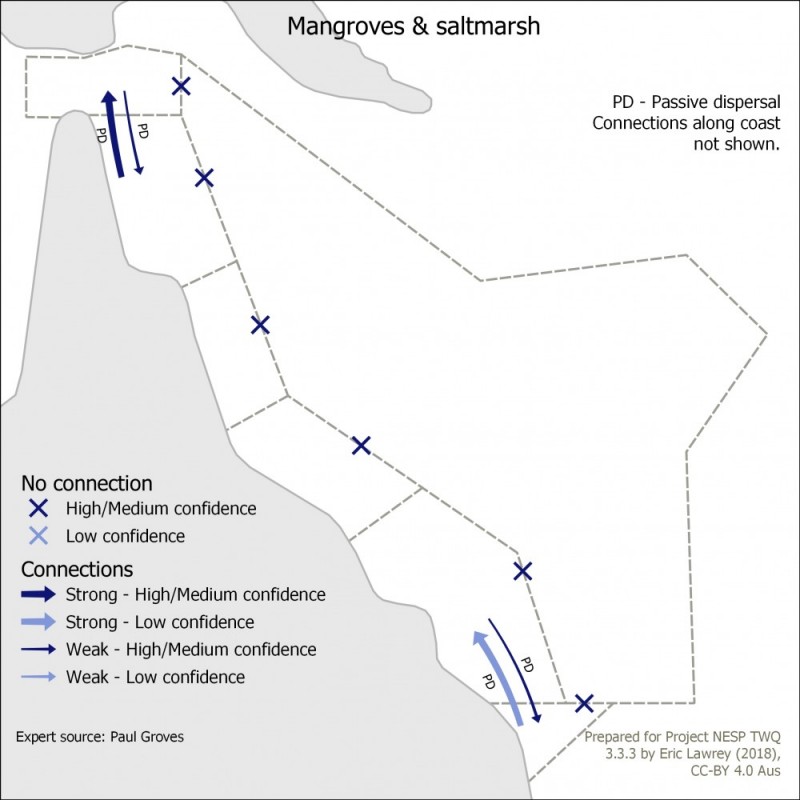Mangroves & saltmarsh
What are mangroves and saltmarsh and why they are important?
Mangroves are part of a mosaic of coastal habitats with coral reefs and seagrasses that sustain a diversity of organisms and a variety of industries (e.g. fisheries and tourism). They also protect the coastline against erosion and storms when adequately inter-connected (Guannel et al. 2016, Veitayaki et al. 2017, Zann 1994). Typically, mangroves and saltmarshes are located along the shore or on islands, and tidal estuaries are suitable for mangrove forests, saltmarshes and saltpans to grow (Figure 2), providing important feeding grounds for shorebirds, dugongs, turtles, dolphins, fish, molluscs, crustaceans, sharks and rays.
Mangroves have a number of ecological roles, including buffering waves to create sheltered environments that support many juvenile and adult species of fish and invertebrates (McLeod and Salm 2006). They also provide feeding areas for the adults of many species of demersal fish, some of which reside on reefs during the day and forage over a range of habitats at night (Nagelkerken and Van Der Velde 2004).
Mangrove and saltmarsh habitats are currently impacted by poor upstream land management in coastal catchments and through direct removal to construct coastal infrastructure (Lotze et al. 2006, Waycott et al. 2009). In particular, poorly managed forestry, agriculture and mining operations are increasing the turbidity of coastal waters through sedimentation and increased nutrient inputs are reducing the area and health of mangrove habitats.
Key concepts that relate to connectivity
Mangroves are predominantly intertidal habitats that occur worldwide in the (sub) tropics along sheltered and shallow coastlines (Nagelkerken et al. 2008). Connectivity of mangroves and between mangroves and other coastal habitats (e.g. seagrass and coral reefs) is a fundamental component of many ecological systems (Sheaves 2009) and is central to the distribution of species and maintaining ecosystem functions (Lindenmayer et al. 2008). Studies focusing on the connectivity between mangroves and seagrass beds and adjacent coral reefs with regard to fish movement documented the importance of these connections (Nagelkerken 2007).
While mangrove distribution is presently restricted to a narrow band of estuarine and coastal environments in northeast Australia, rising and falling sea levels have created and destroyed suitable habitats over time (Crowley 1996) and influenced mangrove migration, connectivity and distribution. Mangrove connectivity is governed by the dispersal capabilities of individual species, using propagules disbursed in water, and is therefore a function of the local meso-scale and macro-scale circulation patterns.
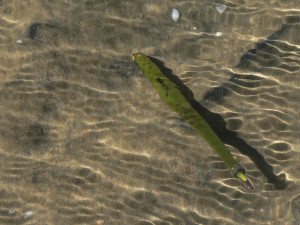
Figure 3. Mangrove seeds germinate on the parent tree, where they continue to grow into propagules. The mature mangrove propagules drop from the trees and float along currents to settle along the coast and become mangrove seedlings. This process is highly dependent on the physical connectivity of ecosystems and there being suitable coastal habitats (without hard barriers) for settlement.
Once the propagule drops from the parent tree there is an obligate dispersal period which each species’ propagule must remain in the water. This dispersal period varies by species, from 40 days (Rhizophora mangle) to 14 days (Avicennia germinans) and 5 days (Laguncularia recemosa). If the propagule strands in a suitable habitat, there is an obligate stranding period before the primary roots and leaves emerge (Figure 3). This also varies by species with the longest obligatory stranding period being 15 days (Rhizophora mangle). The dispersal period determines the distance that a propagule can travel in the ocean currents, and therefore the spatial distribution and connectivity of mangrove species and populations. Importantly, factors that interrupt or impact on propagule dispersal or settlement, such as pollution and physical barriers, can disrupt mangrove connectivity and may require cross-jurisdictional cooperation to manage.
References
Crowley, G.M. (1996) Late Quaternary mangrove distribution in northern Australia. Australian Systematic Botany, 9(2), 219-225.
Guannel, G., Arkema, K., Ruggiero, P., Verutes, G., (2016) The Power of Three: Coral Reefs, Seagrasses and Mangroves Protect Coastal Regions and Increase Resilience. Plos One 11, e0158094.
Lindenmayer, D., Hobbs, R. J., Montague-Drake, R., Alexandra, J., Bennett, A., Burgman, M., Cale, P., Calhoun, A., Cramer, V., Driscoll, D., Fahrig, L., Fischer, J., Franklin, J., Haila, Y., Hunter, M., Gibbons, P., Lake, S., Luck, G., Macgregor, C., Mcintyre, S., Macnally, R., Manning, A., Miller, J., Mooney, H., Noss, R., Possingham, H., Saunders, D., Schmiegelow, F., Scott, M., Simberloff, D., Sisk, T., Tabor, G., Walker, B., Wiens, J., Woinarski, J., Zavaleta, E. (2008) A checklist for ecological management of landscapes for conservation. Ecology Letters, 11, 78- 91.
Lotze, H.K., Lenihan, H.S., Bourque, B.J., Bradbury, R.H., et al. (2006) Depletion, degradation, and recovery potential of estuaries and coastal seas. Science 312, 1806–1809.
McLeod, E., Salm, R.V. (2006) Managing Mangroves for Resilience to Climate Change. International Union for Conservation of Nature, Gland, Switzerland.
Moberg, F., Folke, C. (1999) Ecological goods and services of coral reef ecosystems. Ecological Economics, 29(2), 215-233.
Nagelkerken, I. (2007) Are non-estuarine mangroves connected to coral reefs through fish migration? Bulletin of Marine Science, 80, 595–607.
Nagelkerken, I., Van Der Velde, G. (2004) Relative importance of interlinked mangroves and seagrass beds as feeding habitats for juvenile reef fish on a Caribbean island. Marine Ecology Progress Series 274, 153–159.
Nagelkerken, I.S.J.M., Blaber, S.J.M., Bouillon, S., Green, P., Haywood, M., Kirton, L.G., Meynecke, J.O., Pawlik, J., Penrose, H.M., Sasekumar, A. and Somerfield, P.J. (2008) The habitat function of mangroves for terrestrial and marine fauna: a review. Aquatic Botany 89(2), 155-185.
Sheaves, M. (2009) Consequences of ecological connectivity: the coastal ecosystem mosaic. Marine Ecology Progress Series, 391, 107-115.
Veitayaki, J., Waqalevu, V., Varea, R., Rollings, N. (2017) Mangroves in Small Island Development States in the Pacific: An Overview of a Highly Important and Seriously Threatened Resource. In Participatory Mangrove Management in a Changing Climate (pp. 303-327). Springer, Tokyo.
Waycott, M., Duarte, C.M., Carruthers, T.J.B., Orth, R.J. et al. (2009) Accelerating loss of seagrasses across the globe threatens coastal ecosystems. Proceedings of the National Academy of Sciences USA 106, 12377–12381.
Zann, L.P. (1994) The status of coral reefs in South Western Pacific Islands. Marine Pollution Bulletin, 29, 52-61.




